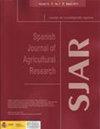Trends and gaps in tomato grafting literature: a systematic approach
IF 0.8
4区 农林科学
Q3 AGRICULTURE, MULTIDISCIPLINARY
引用次数: 0
Abstract
Aim of study: To investigate the trends and existing research gaps in tomato grafting by employing scientometric methods. Area of study: In silico at SCOPUS database. Material and methods: Research articles were retrieved by combining the search terms related to tomato and grafting. The articles were selected according to pre-established criteria. Temporal trends and scientometric indexes were determined. Bibliometric mappings were conducted to determine the main countries, authors, and journals that published articles on tomato grafting; and to acquire collaboration and keywords co-occurrence networks. Technical aspects of tomato grafting were analyzed. Main results: A total of 397 research articles published from 1944 to 2020 were analyzed. The number of publications on tomato grafting increased at an annual rate of 8.8%. The USA and Spain are notable in terms of the number of published and cited articles. The USA and European countries had the highest number of collaborations. European authors had the strongest research connections. Interspecific grafts (61.83%) and experiments in controlled conditions (82.87%) predominated. The growing interest in tomato grafting has been observed as a means of overcoming environmental issues as well as yield and quality improvement. Research highlights: Collaboration among research groups contributed to a higher research impact on the theme. The mitigation of abiotic stresses and fruit quality has risen as significant concerns for tomato crops.番茄嫁接文献的发展趋势和差距:一种系统的方法
研究目的:应用科学计量学方法探讨番茄嫁接技术的发展趋势和存在的研究空白。研究领域:SCOPUS数据库的计算机。材料和方法:结合番茄和嫁接相关的检索词检索研究文章。这些文章是根据预先确定的标准挑选的。确定了时间趋势和科学计量指数。进行文献计量映射,以确定发表番茄嫁接文章的主要国家、作者和期刊;以及获取协作和关键词共现网络。对番茄嫁接技术进行了分析。主要结果:对1944年至2020年发表的397篇研究文章进行了分析。关于番茄嫁接的出版物数量以每年8.8%的速度增长。美国和西班牙的出版物和引用文章数量显著。美国和欧洲国家的合作次数最多。欧洲作家的研究关系最为密切。种间移植物(61.83%)和对照条件下的实验(82.87%)占主导地位。人们对番茄嫁接越来越感兴趣,认为它是克服环境问题以及提高产量和质量的一种手段。研究亮点:研究小组之间的合作有助于提高对该主题的研究影响力。减轻非生物胁迫和果实质量已成为番茄作物关注的重要问题。
本文章由计算机程序翻译,如有差异,请以英文原文为准。
求助全文
约1分钟内获得全文
求助全文
来源期刊

Spanish Journal of Agricultural Research
农林科学-农业综合
CiteScore
2.00
自引率
0.00%
发文量
60
审稿时长
6 months
期刊介绍:
The Spanish Journal of Agricultural Research (SJAR) is a quarterly international journal that accepts research articles, reviews and short communications of content related to agriculture. Research articles and short communications must report original work not previously published in any language and not under consideration for publication elsewhere.
The main aim of SJAR is to publish papers that report research findings on the following topics: agricultural economics; agricultural engineering; agricultural environment and ecology; animal breeding, genetics and reproduction; animal health and welfare; animal production; plant breeding, genetics and genetic resources; plant physiology; plant production (field and horticultural crops); plant protection; soil science; and water management.
 求助内容:
求助内容: 应助结果提醒方式:
应助结果提醒方式:


